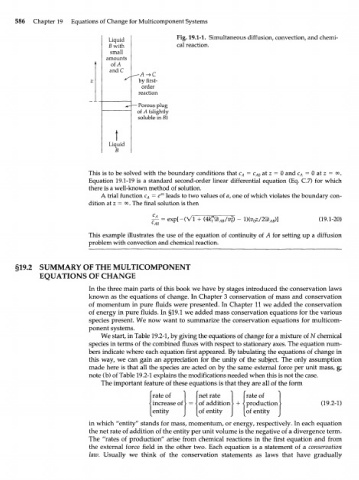Page 606 - Bird R.B. Transport phenomena
P. 606
586 Chapter 19 Equations of Change for Multicomponent Systems
Liquid Fig. 19.1-1. Simultaneous diffusion, convection, and chemi-
В with cal reaction.
small
amounts
of Л
and С
by first-
order
reaction
- Porous plug
of A (slightly
soluble in B)
Liquid
В
This is to be solved with the boundary conditions that c A = c A0 at z = 0 and c A = 0 at z = oo.
Equation 19.1-19 is a standard second-order linear differential equation (Eq. C.7) for which
there is a well-known method of solution.
az
A trial function c A = e leads to two values of a, one of which violates the boundary con-
dition at z = oo. The final solution is then
-£ = exp[-(vT (19.1-20)
This example illustrates the use of the equation of continuity of A for setting up a diffusion
problem with convection and chemical reaction.
519.2 SUMMARY OF THE MULTICOMPONENT
EQUATIONS OF CHANGE
In the three main parts of this book we have by stages introduced the conservation laws
known as the equations of change. In Chapter 3 conservation of mass and conservation
of momentum in pure fluids were presented. In Chapter 11 we added the conservation
of energy in pure fluids. In §19.1 we added mass conservation equations for the various
species present. We now want to summarize the conservation equations for multicom-
ponent systems.
We start, in Table 19.2-1, by giving the equations of change for a mixture of N chemical
species in terms of the combined fluxes with respect to stationary axes. The equation num-
bers indicate where each equation first appeared. By tabulating the equations of change in
this way, we can gain an appreciation for the unity of the subject. The only assumption
made here is that all the species are acted on by the same external force per unit mass, g;
note (b) of Table 19.2-1 explains the modifications needed when this is not the case.
The important feature of these equations is that they are all of the form
r
rate of (net rate | [rate of
< increase of = \ of addition > + < production J (19.2-1)
I entity I of entity I I of entity
in which "entity" stands for mass, momentum, or energy, respectively. In each equation
the net rate of addition of the entity per unit volume is the negative of a divergence term.
The "rates of production" arise from chemical reactions in the first equation and from
the external force field in the other two. Each equation is a statement of a conservation
law. Usually we think of the conservation statements as laws that have gradually

